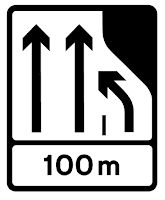Metric direction signs
Two possible examples of Non-Primary / Local route direction signs after conversion:Metric chevron direction signs
Converting these are straightforward. Condensed fonts are recommended where required to increase available space.Distance chevron signs for Non Primary / Local routes are shown below:
Again, a design decision needs to be made whether to have km on the top, or alongside each number.
If there is only one distance on the chevron, one can have the distance alongside the number unconditionally, for unclassified routes as shown below:
Demonstrated above is how condensed fonts can be used to increase the available space, hence the two possible "Eversley 800m" signs.
On distance signs, fractions are best avoided where possible. Unavoidable cases, as well as why fractions are best avoided, are illustrated below:
It is better to use whole numbers of km or m where possible. If 90% accuracy is impossible, then can one use metres to display the number (e.g. 800 m or 1500 m), or use fractions (e.g. 4.5 km or 3.5 km) at the discretion of whoever is converting the signage, and is better to go for whole numbers of metres instead where possible. Note that this scheme only applies to certain types of distance sign (chevron direction, direction, and route confirmation).
More example signs are shown below in various different contexts:
The most important thing is to ensure 90% accuracy. If 90% accuracy can be achieved using km with whole numbers (or m with whole numbers if applicable), that should be used wherever possible. It must be noted that on the vast majority of direction signs and route confirmation signs, only whole numbers of km will be present, and with whole numbers of metres on other signs (especially various chevron direction signs).
By contrast, junction ahead signs (including for motorway) and other short distance signs (such as service exit approach signs), should only use metres as the distances will be short (3000 m or less). Similarly, supplementary plates for hazard warning and similar signs should also use metres where the distances are less than 3000 m.
End of motorway a certain distance ahead
The conversion of these signs are very straightforward, simply replace the mile equivalent with the km or m equivalent.Fractional km or m should always be avoided where possible, and a 90% accuracy must be ensured. I suggest that km should only allowed for more than 3 km, and metres only for 3000 m (3 km) or less. Examples are shown below:
Lane Merge (Lane Drop) and other similar signs
Signs for lane merge / lane drop are shown below:Similar updates will need to be done for signs on slip road which show the main carriageway. The below example is for a slip road entrance to a primary route dual carriageway, but where a lane gets added:














Looks defenitely good with the exceptions of having km on the top instead aside the number.
ReplyDeleteI suggest you to look at countries which uses the same scheme as the UK but uses metric units for your own reference (e.g. Hong Kong)
ReplyDelete